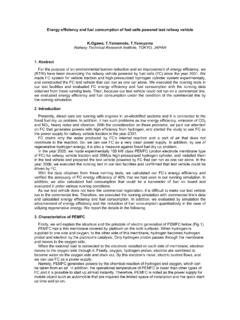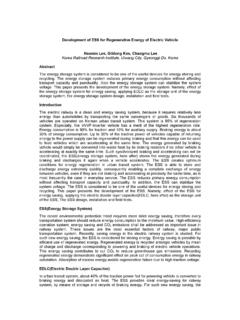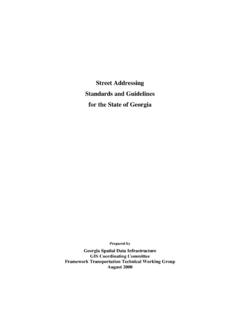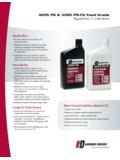Transcription of Headways on High Speed Lines - Railway Research
1 Challenge F: Even more trains even more on time - p. 1 - Headways on high Speed Lines D. Emery cole Polytechnique F d rale de Lausanne, LITEP Group, Station 18 - EPFL - CH-1015 Lausanne - Switzerland Abstract Some parts of the European high Speed line network are near saturation. ETCS-L2, the so called Level 2 of the European train control system, standard for providing signalling and automatic train protection (ATP) on new high Speed Lines (HSL), offers a pretty good level of capacity. However, even with the mobile block system provided by ETCS-Level 3, it seems quite impossible for the practical capacity to reach 20 trains per hour per HSL track as soon as maximal Speed is at 300 km/h or higher. At very high Speed , headway between trains is mainly determined by the braking performance of the trains. The paper presents a new running mode using relative braking distances on one hand, and keeping absolute emergency distances in any case on the other hand.
2 The devised running mode is here described within the classical ETCS_L2 context, where signalling still uses track circuits or axle counters. This secure mode of operation could offer a practical capacity more than 20% higher than the today ETCS_L2 Full Supervision mode. Keywords: Braking curves, Capacity, ERTMS, ETCS, headway , HSL, ATO 1. Introduction: Minimum technical headway at high Speed The European Train Control System (ETCS) was firstly developed to offer to the European Rail community a common Automatic Train Protection system in replacement of the existing ones. In theory, this is needed urgently as more than 15 different and incompatible ATP systems equip the European main rail networks, which obviously preclude interoperability. The level 2 of ETCS (ETCS_L2) provides in cab signalling and allows braking distances over numerous block sections.
3 Strong impact on headway of the service braking absolute distance Equation (1) gives a general formula to calculate the minimum technical headway hmin. )1([sec]211minIXLtoindtvLLdvnth With: tind=indication/watching time [sec], n=number of block sections needed by a train to stop from cruising Speed , d=safe average service deceleration [m/s2], v= Speed [m/s], Lo=overlap length [m], Lt=train length [m] and tIXL=interlocking time [sec] Comprehensive explanations for equation (1) can be found in [Emery, 2008] and many other documents. As soon as v is high and n higher than 4 or 5, hmin comes close to the minimum technical headway obtained by moving block systems. )2([sec] vdvh With: d=safe average deceleration [m/s2], v= Speed [m/s], n=5, Lo=100m,Lt=train length=400 m, and tw+ti=10 sec Challenge F: Even more trains even more on time - p. 2 - Considering equation (2) deduced from equation (1), and with v=300 m/s and d= m/s2, the part v/d is 75% of hmin.
4 However, significant increasing of the service deceleration is very challenging. A new way has to be searched for keeping the technical headway low at very high Speed . 2. Twin Full Supervision: Relative service braking distance coupled with absolute emergency braking distance Dealing with two main objections about relative service braking distance Absolute service brake distance seems to be an irremovable concept of modern railways, as two main relevant objections are systematically made regarding relative brake distances: "When points are to be moved between two trains the second one has to have full braking distance to the points until the points are locked in the new position. Another problem is that in case of an accident of the first train the second train has no chance to stop and is going to collide with the first train. Because of these problems, train separation in relative braking distance is only a theoretical idea with no realistic chance to be adopted in Railway transportation.
5 " [Pachl, 2004] When we talk about relative braking distances, we generally do no distinguish between service braking and emergency braking. Two reasons, valid during the whole 20th century, have confirmed this shortcut. The first is the relatively low difference in distance between a full braking application and an emergency braking application for relatively high Speed trains in poor adhesion conditions, as the stronger and faster depletion along the brake pipe in emergency conditions brings only a better deceleration during the very first seconds of the braking, and almost nothing for modern passenger trains whose braking system is equipped with electric driven valves. The second is that the Speed of a preceding train was unknown and could not be used to consider relative braking distances. Nowadays, both those reasons can be challenged.
6 The couple ETCS/GSM-R allows information about train Speed to be transmitted to the ground and then to other trains - if necessary. Furthermore, Eddy-Current Brakes, independent of adhesion conditions, are in service on some high Speed trains and let consider powerful emergency braking, in particular at very high Speed . Relative service braking distance without a safety-net leads to an unacceptable risk Already in 2004, Alstom asserted the potentiality of capacity enhancement through the use of relative braking distances [Lac te, 2004]. However the risk of consecutive accidents due to derailment of a preceding train was mistakenly minimised. It is indeed psychologically hard to accept an increase of the risk due to a new operation design. How would have react people if the recent disaster in Eschede1 was worsened by the subsequent collision of another train running normally behind?
7 More recently, RFF, in charge of the saturated HSL Paris-Lyon, took up the relative distance idea again: "A significant increase in the capacity of the Lines will only be possible by taking into account, at least partially, the relative distance from braking of the trains, rather than the absolute distance as it is used in the Railway system" [Castan, 2006]. The purpose is then qualified. Relative braking distances offer more capacity but must induce no additional risk in any case. Absolute emergency braking distance is the safety-net we need to increase capacity Already for conventional rail, a lot of ATP systems (KVB, ZUB, ..) use the absolute emergency braking curve as safety-net. Even ERTMS/ETCS uses the emergency braking curve as a last resort to avoid reaching the Supervised Location (SvL) beyond the End of Authority (EOA). So, a new mode of operation, mixing absolute and relative braking distances, seems to be one promising way to reduce the technical headway and thus increase capacity without reducing safety.
8 Service Brake Maximal Deceleration Curve and Emergency Brake Minimal Deceleration Curve The proposed mode of operation was described recently [Emery, 2008 & 2009]. Its main requirements, translated here in the ETCS_L2 context, is to have at one's disposal three new braking curves in addition to the whole family of ETCS_L2 braking curves. The first one, the so-called Service Brake Maximum Deceleration Curve (SBMD) of the preceding train, determines the shift ahead of the 1 Eschede: Accident of an ICE which derailed and collided with a bridge pillar and thus brought within a couple of meters from 200 km/h to still. Challenge F: Even more trains even more on time - p. 3 - End of Authority (EOA) with the recalculation of the associated braking curves. The second one, the so-called Emergency Brake minimum Deceleration curve (EBmD), protects the Emergency Supervision Location (SvL_E), which always stays behind the preceding train.
9 The last one, the Emergency Brake Intervention curve (EBmI), can be easily deduced from its associated EBmD curve. The Emergency Supervised Location (SvL_E) could jump from one block section to another or follow a more frequent update of the safe rear-end position of the preceding train. In this paper, it is admitted that all braking curves are updated only after each track section release. When the P/GUI curve intervenes long before the EBmD curve (cf. figure 1 - case #2), this new mode is compatible with the classical manual driving of trains. Nevertheless, Automatic Train Operation (ATO) is highly recommended in both #1 and #2 cases. P/GUI_T2 EBmD_T2speed2"ru nning at emergencybrake absolute distance"T2T1 Case #1 EOASBMD_T1 SvLSBMD_T1speed2"runn in g at p ermittedspeed distance"T2T1 Case #2distance2v2vSvL_ESvL_EEOASvLEBmD_T2P/G UI_T2distance Figure 1: The Emergency Supervised Location SvL_E and the two possible cases Twin Full Supervision and Automatic Train Operation Such a new mode of operation can be called "Twin Full Supervision" (TFS) as two locations are simultaneously supervised.
10 Depending namely on the Service Brake Maximum Deceleration Curve (SBMD) of the first train, on the Permitted/Guidance Deceleration Curve (P/GUI), and on the Emergency Brake minimum Deceleration Curve (EBmD) of the second train, the first braking curve encountered by the following train could be either the P/GUI curve or the EBmD curve (cf. figure 1). This TFS mode is generally useful only above 200 km/h. In fact, only high Speed provides a Service Brake minimal distance (SBmd) for the first train long enough to allow a jump of the EOA, over the first train, one or many block sections ahead. ATO is not compulsory as long as speeds are higher than 200 km/h and emergency braking performance is significantly higher than the P/GUI one. However, ATO is strongly recommended, as it can not only deal with both cases (cf. figure 1) but can also be coupled with complex driving algorithms to offer a smooth control and an optimal anticipation.

















